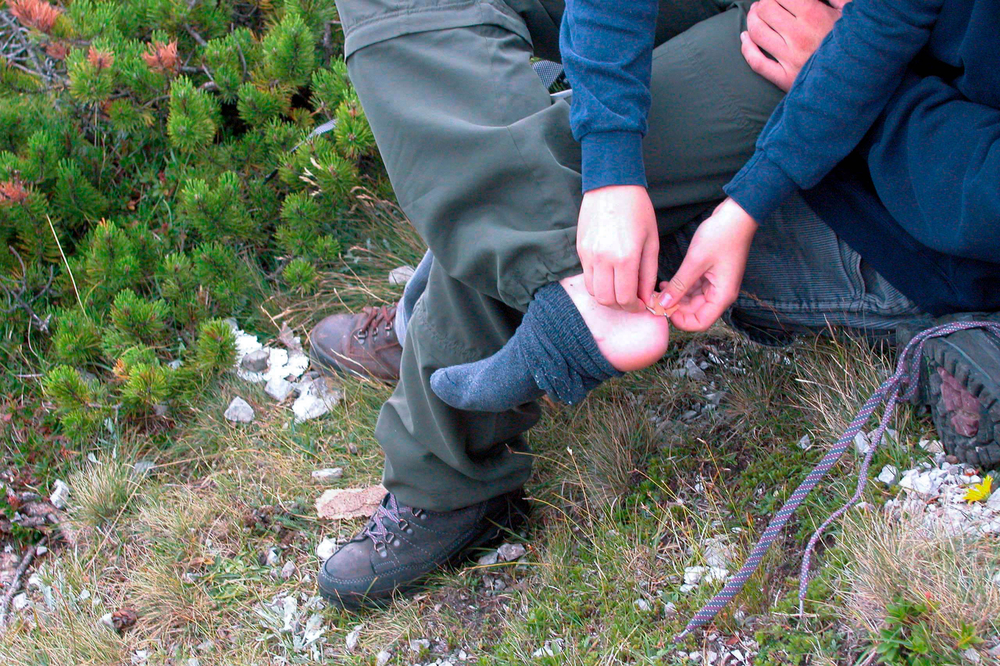Although blisters aren’t usually dangerous, they can be extremely painful and prevent patients from moving around freely. There are many ways of avoiding them. Some of the best strategies include always wearing good shoes and socks, using soft bandages or blister products on sore spots, and stopping activities that cause discomfort. Patients should see a Kelowna, BC or Victoria, BC foot doctor if they have a persistent or infected blister.
How Can You Avoid Getting Blisters on Your Feet?
Blistering happens when an area of the foot repeatedly rubs against another surface. In an attempt to protect itself from damage, the skin develops a fluid-filled blister that acts as a cushion and allows the tissue underneath to heal. Some people are more prone to blistering than others due to genetic factors or the shape of their feet.
You can do several things to prevent skin damage. Always wear good shoes, and choose socks made from natural fibres. You might have to buy several pairs of socks and shoes if you participate in various activities. Protect sensitive areas of your feet with bandages, anti-blister products, powder, or petroleum jelly. Stop participating in activities as soon as you notice that they are causing you foot pain.
Wear Good Shoes
Wearing good shoes is one of the best things you can do for your feet. Not only do breathable, well-fitted shoes reduce your risk of developing a blister, but they also protect your feet from hammer toes, bunions, and a range of other conditions. When you’re out shopping, always try on footwear to see whether it’s suitable. Walk around for a few minutes, and check that there is no pinching or grating.
Avoid wearing high-heeled shoes for prolonged periods because they put a lot of pressure on the balls of your feet and toes. Choose soft leather or fabric instead of stiff leather, and make sure your feet can breathe in your shoes to prevent a buildup of sweat. If you’re not sure how to select appropriate footwear, book an appointment at Island Foot Clinics. We can analyze your foot shape and let you know what shoes are best.
Choose the Right Socks
Great socks can also reduce the likelihood of blistering. In recent years, several products have been created specifically for people who often suffer from this issue. If you regularly get a blister when wearing new shoes or participating in sports, buy socks made from Coolmax or Merino wool. Natural fibres are better than synthetic ones.
Thickness also makes a difference. Socks that are too thin don’t adequately protect your feet, so they aren’t great if you’re going on a hike or participating in long-distance running. However, thinner socks are better if you’re in a wet environment or your feet are extremely sweaty. They allow the water to drain away more quickly.
Consider Soft Bandages or Blister Products
If you already know where you’re likely to develop a blister, take measures before you put on your socks and shoes. Apply a soft bandage to the area to protect it, or buy blister-prevention products from your local pharmacy. Adhesive bandages are usually best because they don’t come off very easily. You can also apply powder or petroleum jelly to sensitive areas of your feet. This reduces friction when your skin rubs together or against the fabric of your socks.
Stop Your Activity If You Feel Discomfort
Sometimes, you don’t notice that you have a blister until you take your shoes off. However, this is rare. You might feel pressure, chafing, and pain before your skin produces a blister. In this case, stop moving around as soon as you can, and take your shoes off to check on your feet. You might be able to resolve the problem by rearranging your socks or tying your shoes less tightly.
How to Treat a Blister
Most people don’t have to see a Kelowna, BC or Victoria, BC foot doctor if they get mild blisters. This condition can almost always be treated at home. Patients should rest for at least a few days and avoid wearing shoes that rub against the affected area of the foot. Open wounds have to be disinfected. Because the fluid-filled sac is designed to protect the skin, it’s best not to pop it.
Home Remedies
Loosely cover your blister with a bandage or clean sock during the day to prevent it from getting infected. Avoid putting too much pressure on the blister, and remove the bandage in the evening. If you have to wear shoes that rub against the blistered area, wear padding. There are donut-shaped products available that can be placed around the blister.
Don’t Pop or Drain Your Blister
Although it might be tempting, try not to pop your blister. Your body has created the fluid-filled sac for a reason, and it’s best to leave it in place until the skin underneath has healed. If your blister is extremely large or uncomfortable, you can pop it with a needle that has been sterilized with rubbing alcohol. After letting all the fluid leak out of your blister, disinfect it thoroughly. Don’t remove the blister’s skin because it is there for protection.
Once your blister has deflated, take good care of it. Wash your feet with soap twice a day, and apply disinfectant. Change your socks each day to prevent a buildup of bacteria.
Do You Need to See a Kelowna, BC or Victoria, BC Foot Doctor for Blistered Feet?
If you’re worried about your blister, give us a call. We’re happy to provide you with some information and advice about how to take care of it. During the phone call, we’ll ask you some questions about your symptoms to determine whether you need to come to the clinic.
You might require medical attention if your blister fails to heal on its own or has become infected. Don’t hesitate to reach out if you’re experiencing extreme pain, swelling, and redness. You can also come to see us if you have a blister that keeps coming back. Sometimes, blistering is the symptom of a postural issue or a foot condition like bunions.
How Can a Foot Specialist Help?
When you arrive at the clinic, we’ll start by checking your blister and asking you about its cause. If your blister has become infected, we might ask you to take a course of antibiotics. After administering treatment, we’ll speak to you about how you can prevent future problems.
We’ll analyze your footwear to determine whether you need to purchase different kinds of shoes. If you have a postural issue that is causing you to place too much pressure on an area of your foot, we might recommend physical therapy or orthotics. By resolving the underlying condition, we can help you prevent future foot conditions.
Blisters are painful and disruptive, and they can sometimes lead to complications like infections. To prevent them, always wear good shoes and socks and stop activities that cause pain. If you know you’re prone to foot problems, wear soft bandages or blister products. Get in touch with us at Island Foot Clinics in Kelowna, BC or Victoria, BC and ask to speak to a foot doctor as soon as you notice that your blister is infected.

